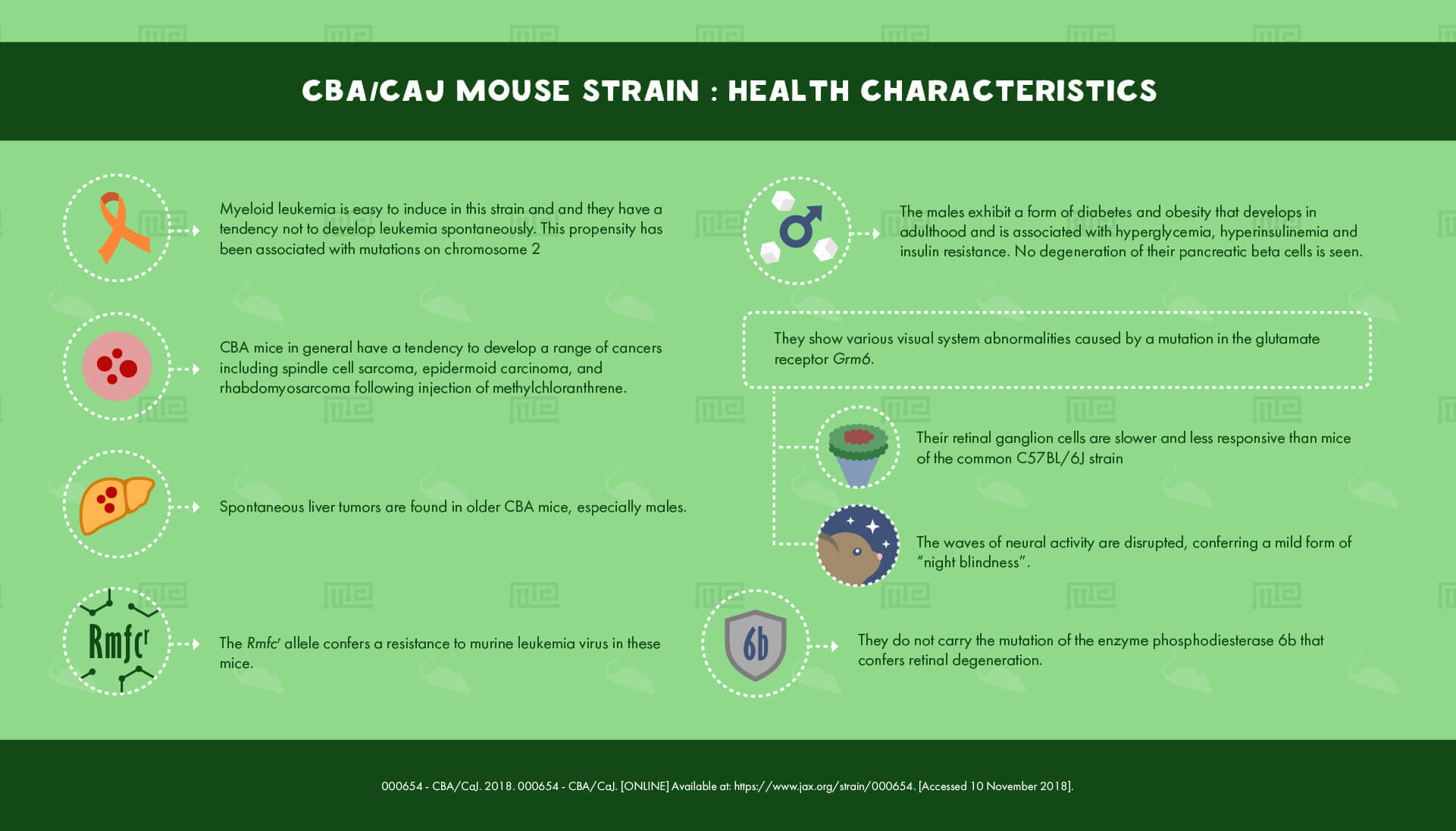History
CBA/CaJ mice share origins with the CBA/J and C3H/J strains, all three having originated from a cross between a Bagg albino female and a male progenitor of the DBA strain. This was carried out by Strong in 1920. The mice then passed through several owners around the world before coming to Green at the Jackson Laboratory in 1950.[1][2]
Physical Characteristics
CBA/CaJ mice have light brown fur and are very similar in appearance to mice of the CBA/J strain. The two strains are not histocompatible.[1]
Behavioral Characteristics & Handling
The Jackson Laboratory makes some cautionary remarks on the handling of CBA/CaJ mice. Specifically, these mice are described as “hyperactive” and “very jumpy, especially when disturbed”.[3] Researchers should exercise great care then when handling this strain and may want to look elsewhere if a more docile strain is required.
CBA/CaJ mice are also prone to barbering, although they are described as “clean”, and are good parents.[3]
As a result of not exhibiting retinal degeneration (see below) CBA/CaJ mice perform better in tests of spatial memory, such as the Morris water maze, than CBA/J mice.[4]
Health Characteristics
The ease of inducing myeloid leukemia in this strain (and its tendency not to develop leukemia spontaneously) has made it of especial interest for leukemia researchers. This propensity has been associated with mutations on chromosome 2.
CBA mice in general display a tendency to develop a range of cancers including spindle cell sarcoma, epidermoid carcinoma, and rhabdomyosarcoma following injection of methylchloranthrene. Spontaneous liver tumors are found in older CBA mice, especially males. The Rmfcr allele confers a resistance to murine leukemia virus.
Male CBA/CaJ mice exhibit a form of diabetes and obesity that develops in adulthood, associated with hyperglycemia, hyperinsulinemia and insulin resistance. No degeneration of their pancreatic beta cells is seen.
These mice also show various abnormalities in their visual system. While the retinal structure is normal, their retinal ganglion cells are slower and less responsive than mice of the common C57BL/6J strain, and the waves of neural activity are disrupted, conferring a mild form of “night blindness”. These abnormalities are caused by a mutation in the glutamate receptor Grm6.
Unlike CBA/J mice (and mice of many other strains), CBA/CaJ mice do not carry the mutation of the enzyme phosphodiesterase 6b conferring retinal degeneration.[1]
Major Experimental Uses
As detailed above, mice of the CBA/CaJ strain find their major application in leukemia research and research on other cancers, as well as in the study of diabetes and obesity.
CBA/CaJ mice have also been used for the testing of cytostatic pharmaceuticals (drugs designed to arrest cell growth), and as hosts for rhabdomyosarcoma xenografts.[1]
It has been common to use CBA mice (both the CBA/J and CBA/CaJ strains) in hearing experiments, as examples of mice with “good hearing”. However, recent research suggests that CBA/CaJ mice show a more rapid decline in hearing capability than CBA/J after one year of age.[5]
References
- 000654 – CBA/CaJ. 2018. 000654 – CBA/CaJ. [ONLINE] Available at: https://www.jax.org/strain/000654. [Accessed 10 November 2018].
- MGI – Inbred Strains: CBA. 2018. MGI – Inbred Strains: CBA. [ONLINE] Available at: http://www.informatics.jax.org/inbred_strains/mouse/docs/CBA.shtml. [Accessed 10 November 2018].
- The Jackson Laboratory Handbook on Genetically Standardized Mice. 6th ed. 2009. [ONLINE]. Available at: http://jackson.jax.org/rs/444-BUH-304/images/JAX%20Handbook%20Genetically%20Standardized%20Mice.pdf.
- Clapcote SJ, Lazar NL, Bechard AR, Roder JC. 2005. Effects of the rd1 mutation and host strain on hippocampal learning in mice. Behav Genet. Sep;35(5):591-601.
- Ohlemiller KK, Dahl AR, Gagnon PM. Divergent aging characteristics in CBA/J and CBA/CaJ mouse cochleae. J Assoc Res Otolaryngol. 2010. 11(4):605-23.


